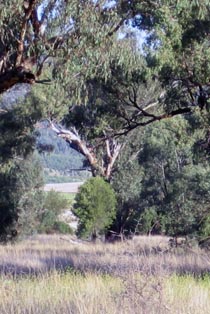About Woodlands
Meet the Animals
Conservation Tips
Puzzles
Further Info
What are Woodlands?
Woodlands are areas of widely-spaced trees of about 10-30 m in height. The canopies generally don't touch and if you stood at the bottom of a tree and looked up you'd see about 10-30% tree and 70-90% sky. This lets through enough sunlight to enable a rich variety of wildflowers, shrubs and native grasses to grow at the understorey and ground levels. This variety is why woodlands are so important for wildlife, offering many different types of habitat to a wide range of animals.
Where are Woodlands?
Before European settlement, woodlands covered 30% of Australia's landmass. Did you know that it was once possible to walk from Sydney to Melbourne through almost continuous woodland? Alas, much of Australia's woodland has been cleared for agricultural usage or urban development. For instance, in the South West Slopes region of NSW, over 85% of woodland has been cleared and much of the woodland which remains is in poor condition. For the animals which rely on woodlands, this rapid landscape change has resulted in a devastating reduction in suitable nesting and feeding places. Indeed, it has resulted in many animals becoming either extinct, locally extinct, threatened or vulnerable.
Types of Woodlands
Generally speaking, there are four main types of woodland - woodland, open woodland, low woodland and low open woodland. The map below shows that lower and more open woodlands are found further inland and taller, less open woodland is found mostly around the Great Dividing Range.

Although most woodlands are dominated by eucalypt species (e.g. Blakely's Red Gum, Yellow Box, White Box, Grey Box, Mugga Ironbark), this is not always the case. She-oaks (casuarina), native cypress pines, banksias and paperbark (melaleuca) trees can also be the dominant tree species within woodland areas.
Why are Woodlands so Important?
Did you know that two-thirds of all Australia's land birds are dependent on woodlands? Or that native vegetation and native wildlife aids agricultural production by providing billions of dollars worth of ecosystem services such as:
- Regulating numbers of insect and vertebrate pest (e.g. rabbits)
- Distributing and cycling nutrients and improving soil quality
- Pollinating plants - did you know that Australia has the highest number of plants pollinated by birds in the world?
In general, woodlands and native woodland wildlife help keep ecosystems in balance.
These are just some of the reasons why it is important to conserve our remaining woodlands.

Left:Distribution of broad woodland types (Source: redrawn from Johnson, R. (2003) Woodlands and open forests of eastern Australia. In Ecology. An Australian Perspective. (Eds. P. Attiwill and B. Wilson). pp. 295-314. Oxford University Press, Melbourne.)

